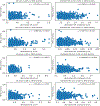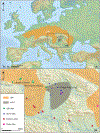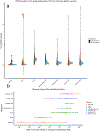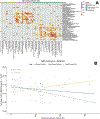Social and genetic diversity in first farmers of central Europe
- PMID: 39613963
- PMCID: PMC11774665
- DOI: 10.1038/s41562-024-02034-z
Social and genetic diversity in first farmers of central Europe
Abstract
The Linearbandkeramik (LBK) Neolithic communities were the first to spread farming across large parts of Europe. We report genome-wide data for 250 individuals: 178 individuals from whole-cemetery surveys of the Alföld Linearbankeramik Culture eastern LBK site of Polgár-Ferenci-hát, the western LBK site of Nitra Horné Krškany and the western LBK settlement and massacre site of Asparn-Schletz, as well as 48 LBK individuals from 16 other sites and 24 earlier Körös and Starčevo individuals from 17 more sites. Here we show a systematically higher percentage of western hunter-gatherer ancestry in eastern than in western LBK sites, showing that these two distinct LBK groups had different genetic trajectories. We find evidence for patrilocality, with more structure across sites in the male than in the female lines and a higher rate of within-site relatives for males. At Asparn-Schletz we find almost no relatives, showing that the massacred individuals were from a large population, not a small community.
© 2024. The Author(s), under exclusive licence to Springer Nature Limited.
Conflict of interest statement
Competing interests: The authors declare no competing interests.
Figures













References
-
- Whittle AWR Europe in the Neolithic: The Creation of New Worlds. (Cambridge University Press, 1996).
-
- Jeunesse C. Pratiques Funéraires Au Néolithique Ancien: Sépultures et Nécropoles Des Sociétés Danubiennes (5500/−4900 Av. J.-C.). (Editions errance, 1997).
-
- Bánffy E. First Farmers of the Carpathian Basin: Changing Patterns in Subsistence, Ritual and Monumental Figurines. (Oxbow books, 2019).
-
- Bánffy E & Oross K in Die Neolithisierung Mitteleuropas (The Spread of the Neolithic to Central Europe) 255–272 (2010).
-
- Bickle P & Whittle A in The First Farmers of Central Europe: Diversity in LBK Lifeways (eds Bickle P & Whittle A) 1–27 (Oxbow Books, 2013).
Publication types
MeSH terms
Grants and funding
LinkOut - more resources
Full Text Sources

